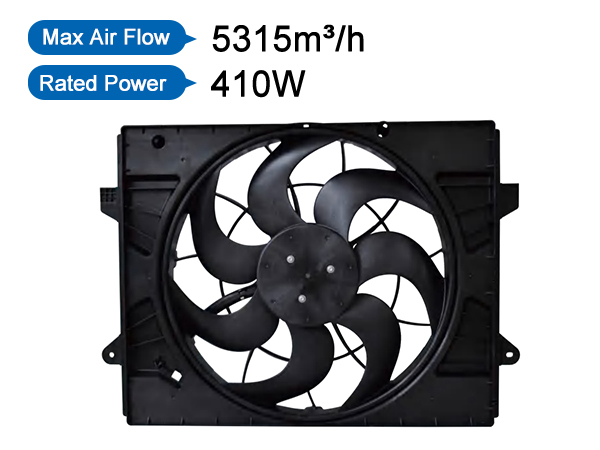Factors affecting the performance of car fans - Analyze various factors that affect car fans
Published:2024-08-08
The performance of car fans is directly related to the operating efficiency and lifespan of the engine. An efficient and durable fan can ensure that the engine can maintain a suitable operating temperature under various working conditions, thereby avoiding performance degradation or even damage caused by overheating. This article will analyze in depth the key factors that affect the performance of automotive fans from multiple dimensions, including material selection, design structure, working environment, and control technology.

1、 Material selection for automotive fans: durability and efficiency
a. Blade material: The material of automotive fan blades needs to have good mechanical strength, heat resistance, and corrosion resistance. Common blade materials include aluminum alloy, plastic (such as ABS, nylon), and carbon fiber composite materials. Aluminum alloy blades are widely used due to their light weight, high strength, and good thermal conductivity, but the cost is relatively high; Plastic blades are favored by the market for their low cost, light weight, and ease of processing and molding, but attention should be paid to their high temperature resistance and long-term stability; Carbon fiber composite materials represent the future development direction, becoming the preferred choice for high-end car models due to their extremely high strength to weight ratio and excellent thermal performance.
b. Bearings and sealing materials: The bearings and seals of the fan are equally critical, as they directly affect the smoothness and durability of the fan's rotation. High quality bearing materials (such as ball bearings) and oil resistant and wear-resistant sealing materials can significantly reduce friction losses, improve the operating efficiency and service life of fans.
2、 Automotive fan design structure: optimizing air flow
a. The shape and quantity of the blades, such as curved, straight, or swept back, directly affect the air supply and efficiency of the fan. Reasonable blade design can minimize air resistance, improve aerodynamic efficiency, and reduce noise to the greatest extent possible. Generally speaking, a larger number of blades results in higher air flow, but the rotational speed may be limited; If the number of blades is small, the speed can be increased, but the air volume may be insufficient, so optimization design needs to be carried out according to specific needs.
b. Fan diameter and speed are important factors determining its air supply capacity. Large diameter fans can achieve a larger airflow at lower speeds, making them suitable for situations that require a large amount of cooling air; Small diameter fans can compensate for the insufficient air volume by increasing the speed, but attention should be paid to the noise and vibration problems that may arise from excessive speed.
3、 Working environment of car fan
a. Temperature and humidity, as well as high temperature and humidity environments, pose higher requirements for the heat dissipation performance and material durability of automotive fans. Working at high temperatures for extended periods of time not only affects the mechanical performance of cycling fans, but may also accelerate material aging. Therefore, it is necessary to use high-temperature resistant materials and optimize the heat dissipation design.
b. Dust and impurities. During the driving process of a car, the fan is prone to inhaling dust, sand, and other impurities, which can block the gaps between the fan blades, affect air circulation, and even damage the fan. Therefore, good sealing design and easy to clean structure are particularly important.
4、 Automotive Fan Control Technology
With the continuous development of automotive electronics technology, intelligent control technology is increasingly being applied to automotive fans. By monitoring engine temperature, vehicle speed and other parameters in real-time through sensors, the intelligent control system can automatically adjust the fan speed and working mode to achieve precise cooling, ensuring the optimal working state of the engine while reducing energy consumption and noise.
In summary, the performance of automotive fans is influenced by multiple factors, from material selection to design structure, to working environment and control technology, every step is crucial. In the future, with the advancement of technology and the increasing demand for environmental protection, automotive fans will develop towards greater efficiency, environmental friendliness, and intelligence.
- Distribution in Water Heater Mattresses: Why BLDC Pumps Ensure Uniform Heating
- How BLDC Pumps Ensure Precise Flow in Water Dispensers
- Why BLDC Pumps Are Essential for Smart Toilets
- The Critical Role of Automotive Electronic Water Pumps in New Energy Vehicle Battery Thermal Management
- Noise Control Technology for Smart Toilet Water Pumps: Enhancing Quiet Operation in Modern Bathrooms
- Unveiling the Working Principle of Automotive Electronic Water Valves
- Comparative Analysis of Liquid-Cooled Pumps vs. Air-Cooled Systems for EV Charging Stations
- Technical Application of Brushless DC Motors in Energy Storage Circulation Pumps
- Water Heater Pump: Efficiency Upgrade for Low-Voltage Systems
- How Dishwasher Water Pumps Enhance Cleaning Coverage Through Stable Operation?
